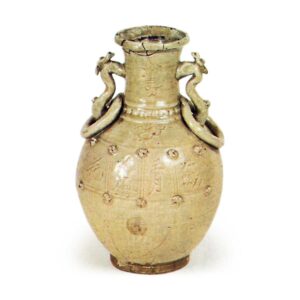
A type of celadon porcelain with a painted floral or comb pattern on the interior surface and a so-called nekotsuki pattern on the exterior surface. Most of them were glazed with a transparent light yellowish-brown glaze, and the clay had a slight iron content. The majority of the pieces are tea bowls, but there are also bowls and plates, all of which are characterized by the lack of glaze on the bottom foot. The name “Jukoh celadon” is derived from the fact that Jukoh’s favorite tea bowls were of this type. However, it is said that the bowl was lost at Honnoji Temple. There is a different theory, and in “Celadon Kohaku,” it is written, “Jukoh was the same period as Ningyo-te, and lived at Shomyo-ji Temple in Nanto, which is why the porcelain in the temple’s collection has this name. The name “Shukoh” was given to the tea ceremony by the people of the world. One of the most famous examples of Jukoh celadon tea bowls from the past is a flawless bowl that belonged to Nagasaki Shosai, a physician in Kyoto, and later became the possession of Kato Masayoshi. Fragments of this type have been found along with Southern Song remains on the coasts of Kamakura, Hakata, and Karatsu Naki-bisu (an old seashore), and remnants have also been excavated from Southern Song sites outside Hangzhou, Zhejiang Province, China. It is almost certainly a piece that does not descend from the Southern Song period. The kiln is said to have been the Yuhang kiln or the Southern Song Yuhao kiln. In the past, it was listed as one of the top Goryeo teacups. Incidentally, this type of tea bowl is generally thinly made, low in height, and flat in shape.



